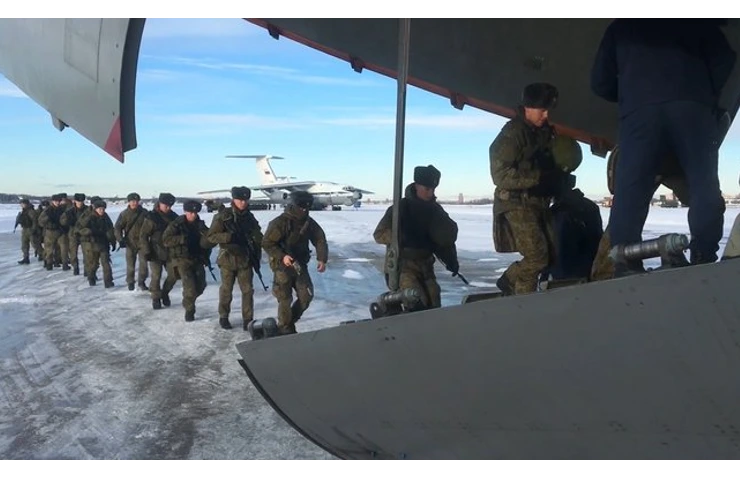The well-coordinated uprising in Kazakhstan, involving thousands of well-trained saboteurs, to topple the government of the pro-Russian President Kassym-Jomart Tokayev had the markings of a Ukraine style regime change.
But a week after famous Kazakh cities including commercial capital Almaty were set aflame, the rebellion has been expertly quelled. Drawing lessons from Ukraine where the famous Maidan square became the icon of a “revolution,” the Russians moved with lightning speed. Grasping the game-plan, where the Republic Square in Almaty could have emerged at Kazakhstan’s equivalent of Maidan square, the Russians quickly mobilised forces. Its army of IL-76 heavy lift planes were swiftly mobilised to inject thousands of troops into the conflict zone.
Russian airborne troops heading towards Kazakhstan as part of the CSTO peacekeeping contingent pic.twitter.com/8BXGPi3Oql
— RT (@RT_com) January 6, 2022
The Russians also took care that they did not make an appearance in the heart of the steppes as occupiers. First, they ensured that the mobilisation took place under the banner of the Moscow-led Collective Security Treaty Organisation (CSTO). Consequently, planes were sent to ferry the troops from CSTO members in Central Asia and Caucasia, including Tajikistan, Kyrgyzstan, Armenia, and Belarus. Leveraging Kazakhstan’s membership of the CSTO, Tokayev formally sought support from the collective. As a result, far from being painted as occupiers, foreign troops were quickly branded as peacekeepers, whose primary role was to secure lawful and established state institutions.
The well-scripted Russian intervention appeared to ride on an intense power struggle between President Tokayev and the ageing warhorse Nursultan Nazarbayev. This is evident from the systematic dismantling of the security apparatus manned by the former President’s loyalists. The first head to roll was that of Nazarbayev protégé, Karim Massimov, former Prime Minister, and the country’s security chief.
After that the President Tokayev, a former diplomat, went for the jugular– sacking Nazarbayev himself as the chairman of the powerful National Security Council. The former strongman was further rendered toothless when the President decreed the sacking on Saturday of the Deputy Secretary of the Security Council Azamat Abdymomunov. Abdymomunov had been appointed Deputy Secretary of the Security Council in June 2015.

Unrest in Kazakhstan (Photo: IANS)
Except for Almaty which continues to simmer, law and order was restored to all of the country’s regions by the morning of January 7, Kazakh authorities said. The heavy lifting accomplished, the painstaking process of detailing a strategic change of guard in the heart of Eurasia, is now to follow. The stage 2 of Kazakhstan’s consolidation under Tokayev appears to have well and truly begun.
Also Read: Kassym-Jomart Tokayev—will he end the Nazarbayev era in Kazakhstan?
Russia’s bold post-Soviet assertion in Kazakhstan has delivered multiple messages. The central message to the United States and the west is that of deterrence. Far from weakening, Moscow remains a global military heavyweight—a message that NATO, engaged in Russia’s encirclement across different geographies can ignore only at its peril. Second, it shows Russia’s resolve to pre-empt a US comeback in Eurasia, after the Biden administration’s messy exit from Afghanistan.
Interestingly, the jury is out on whether Russia’s audacious move may also have a message for China, which shares a border with Kazakhstan and threatens to intrude into Moscow’s backyard, right now with its economic heft, but which could easily mutate into rival political influence. Russia and China are already engaged in a low intensity battle between Moscow’s vision of the Eurasian Economic Union and China's Belt and Road Initiative (BRI) across the Eurasian mainland.
The protests in Kazakhstan may "presumably exacerbate the relations between Moscow and Beijing: they hardly have equal interests in Nur-Sultan," says Ukrainian scholar Mikhail Pogrebinsky, referring to the Kazakh capital, as reported by Tass.
While India will do well not to overtly interfere in the internal affairs of a sovereign state, there could be opportunities downstream to bond independently with the winners in Kazakhstan at a time when the situation is still fluid. With China breathing down Kazakhstan’s neck, it may be a good idea to bond with the Russians, whose interests with China in Eurasia clash. Such a move would be in tune with President Vladimir Putin’s visit to India last month, the coinciding 2+2 dialogue where the CSTO was discussed, and New Delhi’s invitation to all the five Central Asian heads for the upcoming Republic Day.
Kazakhstan: Between a Colour Revolution and Islamic terrorism
Republic Day Diplomacy : India Steps up engagement with Central Asian Republics




















